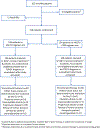Addition of temsirolimus to chemotherapy in children, adolescents, and young adults with intermediate-risk rhabdomyosarcoma (ARST1431): a randomised, open-label, phase 3 trial from the Children's Oncology Group
- PMID: 38936378
- PMCID: PMC11550893
- DOI: 10.1016/S1470-2045(24)00255-9
Addition of temsirolimus to chemotherapy in children, adolescents, and young adults with intermediate-risk rhabdomyosarcoma (ARST1431): a randomised, open-label, phase 3 trial from the Children's Oncology Group
Abstract
Background: The Children's Oncology Group defines intermediate-risk rhabdomyosarcoma as unresected FOXO1 fusion-negative disease arising at an unfavourable site or non-metastatic FOXO1 fusion-positive disease. Temsirolimus in combination with chemotherapy has shown promising activity in patients with relapsed or refractory rhabdomyosarcoma. We aimed to compare event-free survival in patients with intermediate-risk rhabdomyosarcoma treated with vincristine, actinomycin, and cyclophosphamide alternating with vincristine and irinotecan (VAC/VI) combined with temsirolimus followed by maintenance therapy versus VAC/VI alone with maintenance therapy.
Methods: ARST1431 was a randomised, open-label, phase 3 trial conducted across 210 institutions in Australia, Canada, New Zealand, and the USA. Eligible patients were those aged 40 years or younger with non-metastatic FOXO1-positive rhabdomyosarcoma or unresected FOXO1-negative rhabdomyosarcoma disease from unfavourable sites. Two other groups of patients were also eligible: those who had FOXO1-negative disease at a favourable site (excluding orbit) that was unresected; and those who were aged younger than 10 years with stage IV FOXO1-negative disease with distant metastases. Eligible patients had to have a Lansky performance status score of 50 or higher if 16 years or younger and a Karnofsky performance status score of 50 or higher if older than 16 years; all patients were previously untreated. Patients were randomised (1:1) in blocks of four and stratified by histology, stage, and group. Patients received intravenous VAC/VI chemotherapy with a cyclophosphamide dose of 1·2 g/m2 per dose per cycle with or without a reducing dose of intravenous weekly temsirolimus starting at 15 mg/m2 or 0·5 mg/kg per dose for those who weighed less than 10 kg. The total duration of therapy was 42 weeks followed by 6 months of maintenance therapy with oral cyclophosphamide plus intravenous vinorelbine for all patients. Temsirolimus was withheld during radiotherapy and for 2 weeks before any major surgical procedure. The primary endpoint was 3-year event-free survival. Data were analysed with a revised intention-to-treat approach. The study is registered with ClinicalTrials.gov (NCT02567435) and is complete.
Findings: Between May 23, 2016, and Jan 1, 2022, 325 patients were enrolled. In 297 evaluable patients (148 assigned to VAC/VI alone and 149 assigned to VAC/VI with temsirolimus), the median age was 6·3 years (IQR 3·0-11·3); 33 (11%) patients were aged 18 years or older; 179 (60%) of 297 were male. 113 (77%) of 148 patients were FOXO1 negative in the VAC/VI group, and 108 (73%) of 149 were FOXO1 negative in the VAC/VI with temsirolimus group. With a median follow-up of 3·6 years (IQR 2·8-4·5), 3-year event-free survival did not differ significantly between the two groups (64·8% [95% CI 55·5-74·1] in the VAC/VI group vs 66·8% [57·5-76·2] in the VAC/VI plus temsirolimus group (hazard ratio 0·86 [95% CI 0·58-1·26]; log-rank p=0·44). The most common grade 3-4 adverse events were anaemia (62 events in 60 [41%] of 148 patients in the VAC/VI group vs 89 events in 87 [58%] of 149 patients in the VAC/VI with temsirolimus group), lymphopenia (83 events in 65 [44%] vs 99 events in 71 [48%]), neutropenia (160 events in 99 [67%] vs 164 events in 105 [70%]), and leukopenia (121 events in 86 [58%] vs 132 events in 93 [62%]). There was one treatment-related death in the VAC/VI with temsirolimus group, categorised as not otherwise specified.
Interpretation: Addition of temsirolimus to VAC/VI did not improve event-free survival in patients with intermediate-risk rhabdomyosarcoma defined by their FOXO1 translocation status and clinical factors. Novel biology-based strategies are needed to improve outcomes in this population.
Funding: The Children's Oncology Group (supported by the US National Cancer Institute, US National Institutes of Health).
Copyright © 2024 Elsevier Ltd. All rights reserved, including those for text and data mining, AI training, and similar technologies.
Conflict of interest statement
Declaration of interests We declare no competing interests.
Figures
Comment in
-
Future directions for the molecular therapy of rhabdomyosarcoma: how do we detect and investigate new, appropriate target mutations and populations?Transl Pediatr. 2025 Apr 30;14(4):769-772. doi: 10.21037/tp-2024-605. Epub 2025 Apr 27. Transl Pediatr. 2025. PMID: 40386363 Free PMC article. No abstract available.
References
-
- WHO Classification of Tumours Editorial Board: WHO Classification of Tumours. Volume 3: Soft Tissue and Bone Tumours. 5th ed.: IARC Press; 2020.
-
- Rudzinski ER, Teot LA, Anderson JR, Moore J, Bridge JA, Barr FG, et al. Dense pattern of embryonal rhabdomyosarcoma, a lesion easily confused with alveolar rhabdomyosarcoma: a report from the Soft Tissue Sarcoma Committee of the Children’s Oncology Group. Am J Clin Pathol. 2013;140(1):82–90. - PMC - PubMed
-
- Oberoi S, Qumseya A, Xue W, Harrison DJ, Rudzinski ER, Wolden SL, et al. Feasibility of combining temsirolimus to vincristine, dactinomycin, cyclophosphamide, and vincristine and irinotecan chemotherapy for children with intermediate-risk rhabdomyosarcoma: A report from Children’s Oncology Group. Pediatr Blood Cancer. 2023:e30436. - PMC - PubMed
-
- Ries LS; Gurney JG; Linet M; Tamra T; Young JL; Bunin GR (eds). Cancer Incidence and Survival among Children and Adolescents: United States SEER Program 1975–1995, NIH Pub. No. 99–4649. Bethesda, MD, 1999.
Publication types
MeSH terms
Substances
Supplementary concepts
Associated data
Grants and funding
LinkOut - more resources
Full Text Sources
Medical
Research Materials
Miscellaneous




